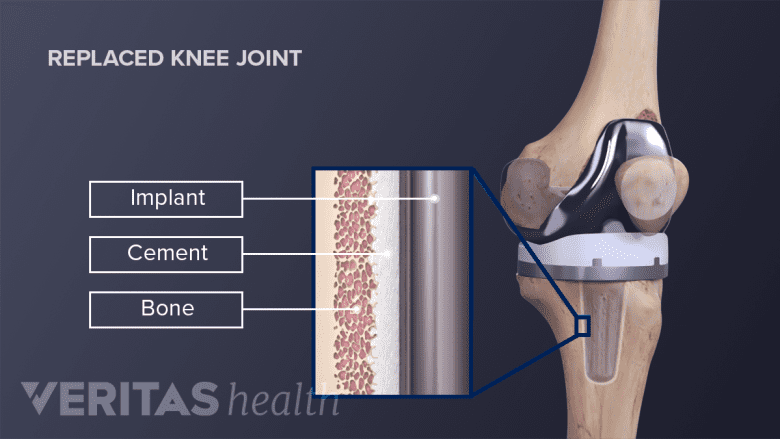During knee replacement, the damaged knee joint is removed and replaced with man-made components. These components are designed to move together like a normal, healthy knee. Manufacturers offer many types of knee components. For example, some components are designed specifically for women, and others may be customized to the patient’s unique knee anatomy.

Most artificial bone components are attached using cement, but cementless options are available.
This page discusses the materials used to make knee components; gender-specific knee components; and custom knee replacement components. A doctor will recommend the components that he or she is believes is best for the individual patient.
In This Article:
- Total Knee Replacement: Facts and Considerations for Patients
- Knee Replacement Components: Options for Patients
Plastic, Metal, and Ceramic Knee Replacement Components
Most prostheses are made from a combination of metal and plastic parts, but a surgeon might also use components that are all metal, all ceramic, or ceramic and plastic.1Medline Plus, National Institutes of Health. "Knee Joint Replacement." http://www.nlm.nih.gov. Accessed June 12, 2018. There are few studies comparing types of prostheses—and even fewer that are not funded by device makers themselves. Due to this lack of research, there is no definitive scientific evidence showing that one type of prosthesis is better than another.2Rajan Anand, Stephen E. Graves, Richard N. de Steiger, David C. Davidson, Philip Ryan, Lisa N. Miller, Kara Cashman, What is the Benefit of Introducing New Hip and Knee Prostheses? The Journal of Bone & Joint Surgery (Am.), Dec 2011; 93 (Supplement_3); 51-54. doi: 10.2106/JBJS.K.00867
Components made of ceramic and/or plastic may be recommended to people with metal sensitivities.3Mitchelson AJ, Wilson CJ, Mihalko WM, et al. Biomaterial Hypersensitivity: Is It Real? Supportive Evidence and Approach Considerations for Metal Allergic Patients following Total Knee Arthroplasty. BioMed Research International. 2015;2015:137287. doi:10.1155/2015/137287.
Custom Knee Replacement Components
Some experts believe that custom components lead to better results for patients.4Culler SD, Martin GM, Swearingen A. Comparison of adverse events rates and hospital cost between customized individually made implants and standard off-the-shelf implants for total knee arthroplasty. Arthroplast Today. 2017 Jun 9;3(4):257-263. doi: 10.1016/j.artd.2017.05.001. eCollection 2017 Dec. PubMed PMID: 29204493; PubMed Central PMCID: PMC5712025. Others believe custom components have limited benefit and should be reserved for patients who have unusual knee anatomy or face challenging revision surgeries.
Custom cutting blocks
Custom cutting blocks are based on the patient’s knee anatomy. The goal is to help the surgeon make precise cuts to the patient’s bone. Research regarding the effectiveness of custom cutting blocks is mixed.5Nam D, Park A, Stambough JB, Johnson SR, Nunley RM, Barrack RL. The Mark Coventry Award: Custom Cutting Guides Do Not Improve Total Knee Arthroplasty Clinical Outcomes at 2 Years Followup. Clinical Orthopaedics and Related Research. 2016;474(1):40-46. doi:10.1007/s11999-015-4216-y.
Custom cutting blocks are used in about 6% of surgeries.6Nguyen L-CL, Lehil MS, Bozic KJ. Trends in total knee arthroplasty implant utilization. J Arthroplasty. 2015;30:739–42. doi: 10.1016/j.arth.2014.12.009. They do not have to be used with custom components.
Gender-specific Knee Replacement Components
Women account for more than half of the knee replacements done in the US each year, and many manufacturers have developed knee components specifically for women. Traditional knee replacement components are used for both men and women, with different sizes used based on knee anatomy.
Cement vs. Cementless Components
Another difference among artificial knee components is how they are affixed to the bone. Components may be attached with bone cement or they may be "cementless," allowing existing bone to grow into them. Nearly 9 in 10 knee replacements use bone cement.6Nguyen L-CL, Lehil MS, Bozic KJ. Trends in total knee arthroplasty implant utilization. J Arthroplasty. 2015;30:739–42. doi: 10.1016/j.arth.2014.12.009.
- 1 Medline Plus, National Institutes of Health. "Knee Joint Replacement." http://www.nlm.nih.gov. Accessed June 12, 2018.
- 2 Rajan Anand, Stephen E. Graves, Richard N. de Steiger, David C. Davidson, Philip Ryan, Lisa N. Miller, Kara Cashman, What is the Benefit of Introducing New Hip and Knee Prostheses? The Journal of Bone & Joint Surgery (Am.), Dec 2011; 93 (Supplement_3); 51-54. doi: 10.2106/JBJS.K.00867
- 3 Mitchelson AJ, Wilson CJ, Mihalko WM, et al. Biomaterial Hypersensitivity: Is It Real? Supportive Evidence and Approach Considerations for Metal Allergic Patients following Total Knee Arthroplasty. BioMed Research International. 2015;2015:137287. doi:10.1155/2015/137287.
- 4 Culler SD, Martin GM, Swearingen A. Comparison of adverse events rates and hospital cost between customized individually made implants and standard off-the-shelf implants for total knee arthroplasty. Arthroplast Today. 2017 Jun 9;3(4):257-263. doi: 10.1016/j.artd.2017.05.001. eCollection 2017 Dec. PubMed PMID: 29204493; PubMed Central PMCID: PMC5712025.
- 5 Nam D, Park A, Stambough JB, Johnson SR, Nunley RM, Barrack RL. The Mark Coventry Award: Custom Cutting Guides Do Not Improve Total Knee Arthroplasty Clinical Outcomes at 2 Years Followup. Clinical Orthopaedics and Related Research. 2016;474(1):40-46. doi:10.1007/s11999-015-4216-y.
- 6 Nguyen L-CL, Lehil MS, Bozic KJ. Trends in total knee arthroplasty implant utilization. J Arthroplasty. 2015;30:739–42. doi: 10.1016/j.arth.2014.12.009.

